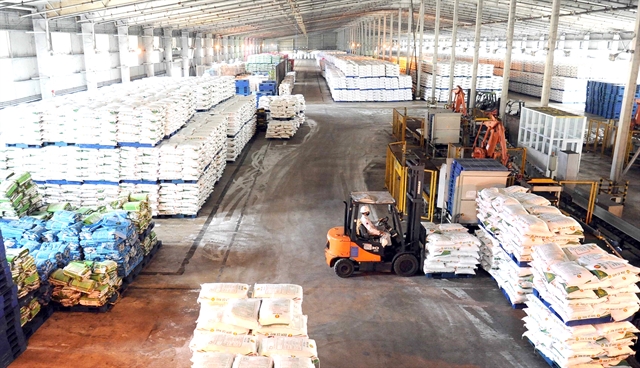 Economy
Economy

The fertiliser industry's gross profit margin may decrease after peaking in the first quarter of 2022, but the fertiliser sector still see positive prospects in the near future, thanks to export growth.

|
| Inside a factory of PetroVietnam Cà Mau Fertiliser JSC (DCM). DCM's net revenue reached VNĐ4.07 trillion in Q1, 2 times higher than the same period last year. VNA/VNS Photo Huỳnh Anh |
HÀ NỘI - The fertiliser industry's gross profit margin may decrease after peaking in the first quarter of 2022, but the fertiliser sector still sees positive prospects in the near future, thanks to export growth.
According to KIS Vietnam Securities Joint Stock Company (KIS), the revenue of the fertiliser industry in the first quarter of 2022 reached VNĐ30.93 trillion (US$1.3 billion), up 71.2 per cent over the same period last year, while profit after tax reached VNĐ6.8 trillion, 7.9 times higher than the previous year.
Leaders in the growth of profit after tax in the first quarter of 2022 are Petrovietnam Fertiliser & Chemicals Corporation (DPM) and PetroVietnam Cà Mau Fertiliser JSC (DCM).
Petrovietnam Fertiliser & Chemicals Corporation (DPM) reported a profit after tax of VNĐ2.12 trillion, up 12 times over the same period last year, exceeding 125 per cent of the yearly plan. This is also the highest quarterly profit in the business's history.
The company said that the revenue and profit in the first three months of the year increased sharply thanks to the positive movement of the selling prices and trading volume of fertilisers.
In 2022, DPM plans to achieve revenue of VNĐ11.06 billion and profit after tax of VNĐ945 billion, up 33 per cent and 158 per cent respectively compared to 2021. In just the first quarter, the business achieved nearly 53 per cent of the revenue target and over 125 per cent of the whole year’s profit plan.
PetroVietnam Cà Mau Fertiliser JSC (DCM) also benefited greatly from the scarcity of supply, leading to higher fertiliser prices in the first quarter of 2022.
Net revenue reached VNĐ4.07 trillion, 2 times higher than the same period last year; in which, urea sales alone reached VNĐ3.77 trillion, accounting for 88 per cent of the total revenue structure. The high growth rate of sales of this product mainly comes from export activities with VNĐ2.19 trillion, 5.5 times higher than the first quarter of 2021.
For the fertiliser industry, in the first quarter of 2022, the total consumption volume remained unchanged from the same period last year while the export volume reached 510,000 tonnes, up 47 per cent over the same period last year and up 31 per cent against the fourth quarter of 2021.
The export volume in the first quarter of 2022 is equivalent to 44 per cent and 40 per cent of the export volume in 2020 and 2021, respectively. KIS Vietnam Securities Joint Stock Company (KIS) said that although the gross profit margin peaked in the first quarter of 2022, it will be difficult to maintain in the next quarters.
Gross profit margin of the fertiliser industry was estimated at 31.7 per cent in the first quarter of 2022. Also in the first quarter, the selling price of urea in the market decreased slightly by 2 per cent compared to the previous quarter, but increased by 99 per cent over the same period last year, while the input gas price increased by 20 per cent compared to the fourth quarter of 2021 and up by 20 per cent against the same period last year.
Input gas price in April increased by 9 per cent while urea price levelled off compared to March. If fertiliser price tends to decrease in the following months, along with the galloping rate of fuel prices due to global political tensions, the fertiliser industry's gross profit margin in the following quarters may decline after peaking in the first quarter of 2022.
Although the growth rate slows down, the fertiliser industry still expects to achieve positive results in the second quarter compared to the same period in 2021.
Taking advantage of opportunities from the fact that fertiliser prices stayed at a high level and domestic demand is falling into a low period, fertiliser manufacturers are rushing to export.
In January alone, fertiliser export volume reached a record high of 370,000 tonnes, bringing the total export volume in the first quarter of 2022 to 510,000 tonnes, equivalent to 44 per cent and 40 per cent of the total export volume in 2020 and 2021, respectively. However, from the second quarter of 2022, our country enters the summer-autumn crop, and domestic fertiliser demand is forecast to increase, so fertiliser companies will find it difficult to boost exports due to the prioritisation of domestic demand.
However, KIS said that companies could recover export volume in the period from the end of the third quarter to the beginning of the fourth quarter of 2022 when the summer-autumn crop enters the harvest phase.
Domestic fertiliser prices are still maintaining high levels. On average, the selling price per kg of urea, potassium, DAP, and NPK in March was VNĐ17,500, VNĐ16,500, VNĐ26,000 and VNĐ16,000, respectively. These prices increased by 84 per cent, 90 per cent, 132 per cent and 62 per cent, respectively over the same period last year.
In April, the domestic price of urea remained unchanged compared to March, while the selling price of potassium, DAP and NPK increased by 3 per cent, 4 per cent, and 6 per cent, respectively.
In order to lower domestic fertiliser prices and stabilise supply, the Ministry of Finance proposes the Government apply a 5 per cent export tax rate on fertilisers, regardless of the percentage of mineral sourced in the country.
KIS Vietnam Securities Joint Stock Company said that the 5 per cent tax rate might not be significant for exporters. The export unit price was high compared to the domestic selling price. In January 2022, the export price reached $808 per tonne, while the domestic price was only $717 per tonne.
On the other hand, the increased domestic demand for fertiliser during the summer-autumn crop, which takes place from April to September every year, can make up for the shortfall in revenue due to export restrictions.
In the first quarter of 2022, the total export output of Petrovietnam Fertiliser & Chemicals Corporation (DPM) and PetroVietnam Cà Mau Fertiliser JSC (DCM) reached about 200,000 tonnes.
According to data from the Ministry of Agriculture and Rural Development, the country has more than 800 fertiliser production facilities, the vast majority of which are NPK fertiliser production facilities with a total designed capacity of over 29 million tonnes per year.
Currently, NPK fertilisers are both exported and imported. Specifically, in 2021, nearly 362,000 tonnes are exported and 435,500 tonnes are imported. NPK is applied export tax of 0 per cent. NPK manufacturers exporting their products to countries in the region will be directly affected if the export tax is increased to 5 per cent.
In Việt Nam, according to Mordor Intelligence, the domestic fertiliser industry will grow 4.9 per cent per year in the 2021 - 2026 period. According to a report by the Ministry of Industry and Trade, in the first four months of this year, export turnover of fertilisers of all kinds increased by 46.9 per cent in volume and up 192.6 per cent in value due to increased export prices. VNS




